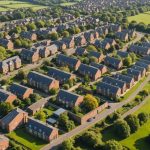Overview of Urban Planning Policies in the UK
The urban planning landscape in the UK has evolved significantly, particularly with an emphasis on wildlife conservation. Current policies aim to strike a balance between development needs and ecological preservation. Regulations call for integrating biodiversity into housing developments through eco-friendly designs and strategic land use.
The National Planning Policy Framework (NPPF) plays a pivotal role by promoting wildlife-friendly measures. It mandates that developers demonstrate enhancements to natural habitats as part of their applications. Frameworks such as Biodiversity Net Gain encourage implementing green infrastructure, like green roofs or pollinator gardens, further supporting local wildlife.
A lire en complément : Essential Tips for UK Residents: How to Build Ideal Bat Boxes in Your Area
Compliance with environmental regulations isn’t merely a legal necessity; it’s crucial for sustainable development. Authorities emphasize environmental impact assessments within the planning process, ensuring that projects adhere to ecological standards and contribute positively to the environment.
Critically, development plans must be nuanced, supporting both urban growth and wildlife sustainability. Through these UK policies, there’s a concerted effort to foster spaces where nature and urban life coexist harmoniously, reinforcing the importance of responsible development for future generations. These efforts not only protect biodiversity but also enhance urban livability, creating environments people are proud to call home.
A lire aussi : Essential Tips for Safely Interacting with Seal Pups on UK Beaches to Minimize Distress
Successful Case Studies of Integration
Integrating conservation and housing is no small feat, but some wildlife-friendly developments have set remarkable examples. Let’s explore a few noteworthy case studies that highlight best practices and innovative strategies.
One exemplary project is the Kingfisher Heights in England. Here, developers focused on maintaining natural habitats by incorporating native plant species and creating man-made features like pond systems. This not only supports local fauna but also boosts biodiversity. Additionally, the development boasts green roofs, which play a crucial role in urban resilience.
In New Zealand, the Waiata Shores Community stands out. This housing project emphasizes eco-corridors that connect urban and natural areas. Developers worked closely with ecologists to ensure habitat restoration and connectivity. Residents enjoy lush green spaces while knowing their homes do not compromise local wildlife habitats.
Common strategies among these successful projects include:
- Habitat preservation
- Incorporation of sustainable architecture
- Community engagement
Lessons learned underscore the importance of early planning. Developers should collaborate with ecologists from the onset to ensure wildlife-friendly measures are integrated organically. These methods are not only applicable globally but also demonstrative of how sustainable practices benefit both human and wildlife realms.
Stakeholder Involvement in Urban Planning
Stakeholder engagement plays a crucial role in urban planning, ensuring that diverse voices are heard and considered. Local community involvement is imperative, as residents are the primary beneficiaries or sufferers of planning outcomes. Their insights and concerns provide valuable input to shape equitable and sustainable urban projects. Including the community fosters a sense of ownership and enhances the project’s acceptance and success.
Collaboration is essential among stakeholders, such as environmental organizations and governmental agencies, which each bring unique expertise and perspectives. Environmental groups advocate for sustainable practices and protect natural resources, influencing eco-friendly infrastructure decisions. Meanwhile, governmental agencies ensure that proposed plans align with regulatory frameworks and policy requirements. By collaborating, these entities can create balanced solutions that satisfy both ecological and regulatory needs.
Strategies for effective stakeholder collaboration involve clear communication channels and regular consultation meetings. Transparent communication builds trust among stakeholders, promoting open dialogue and addressing concerns promptly. Establishing regular meetings allows for continuous feedback, enabling planners to adapt and refine proposals as needed. By integrating these strategies, urban planning processes become more inclusive, creating environments that reflect the diverse needs and aspirations of all stakeholders involved.
Challenges in Integrating Wildlife Conservation
Incorporating wildlife conservation into projects often encounters challenges that can overwhelm even the best-intended developers. A common barrier is aligning competing interests. Balancing the needs of conservation with sustainable development goals frequently pits environmental advocates against those prioritising economic growth. For instance, developers may be pressured to choose profit over sustainable practices, which can undermine conservation efforts.
Economic pressures further exacerbate these challenges, encouraging a focus on immediate gains rather than long-term sustainability. This pressure can result in limited investments in eco-friendly technologies or practices that might initially seem costly but offer future benefits. The economic tension often compels developers to overlook critical conservation concerns.
Moreover, navigating regulatory hurdles is another persistent barrier. Legal frameworks for conservation are frequently complex, creating a labyrinth of policies that can be difficult to manage. Understanding and interpreting these regulations are crucial to ensuring compliance and achieving sustainable development objectives. Successful navigation involves early engagement with regulatory bodies and acquiring permits and necessary documentation upfront.
Addressing these challenges requires a coordinated approach that aligns economic success with environmental integrity, acknowledging that sustainable development and wildlife conservation, though seemingly in opposition, are inherently interconnected goals.
Benefits of Wildlife Conservation in Housing Developments
Integrating wildlife conservation in housing developments reaps numerous benefits, particularly in terms of ecological impacts and sustainable living. By preserving natural habitats, these developments contribute to biodiversity, aiding in the survival of various species. This not only enriches the ecosystem but also strengthens the resilience of the local environment to natural disasters, such as flooding or wildfires, by supporting natural processes and barriers.
From an economic perspective, sustainable housing practices incorporating wildlife conservation can increase property values. Homes surrounded by rich biodiversity often attract buyers seeking a peaceful coexistence with nature. Moreover, such practices help reduce long-term costs through natural pest control, and improved air and water quality, decreasing reliance on costly artificial solutions.
Beyond the environmental and economic advantages, wildlife-friendly communities enhance the well-being of residents. Living amidst nature has been shown to improve mental health, offering serene landscapes and opportunities for recreation and education. Citizens become more engaged, forming a community that values and actively participates in sustainable living practices.
Thus, incorporating wildlife conservation into housing developments is not just an ecological imperative but a holistic approach to improving life quality across several dimensions.
Sustainable Practices for Urban Developers
Urban developers are in a unique position to champion sustainable practices that contribute positively to the environment. By incorporating green building and ecological design strategies, developers can support wildlife while enhancing urban living.
One such approach is the integration of green spaces and corridors. These areas not only provide habitats for local flora and fauna but also offer residents a natural retreat within urban settings. Implementing features like rooftop gardens, vertical plant walls, and rain gardens can significantly boost a project’s environmental impact.
Green corridors serve as ecological pathways that connect fragmented habitats, allowing wildlife to thrive amidst the built environment. They promote biodiversity and improve the ecological resilience of urban areas.
It’s also crucial to engage local communities in maintaining and nurturing these sustainable practices. By encouraging participation in community gardens and educational workshops, urban developments can cultivate a sense of ownership and responsibility among residents. This ongoing involvement ensures long-term success and fosters a sustainable lifestyle.
By combining innovative design with active community engagement, urban developers can create vibrant spaces that enhance urban biodiversity while providing quality living environments.











